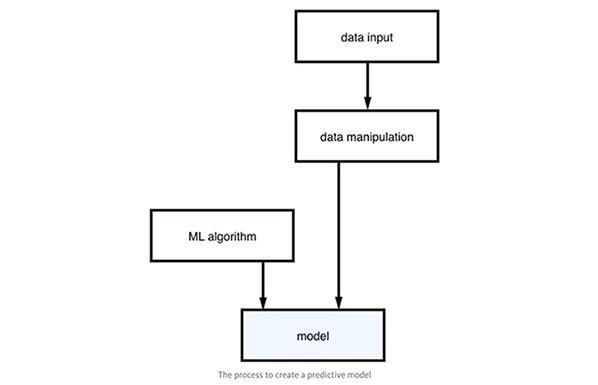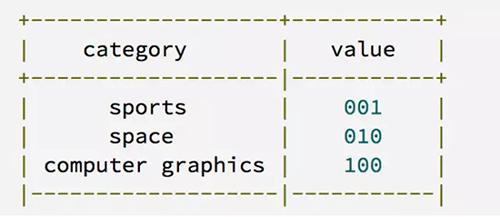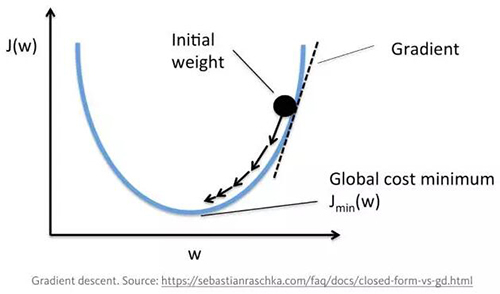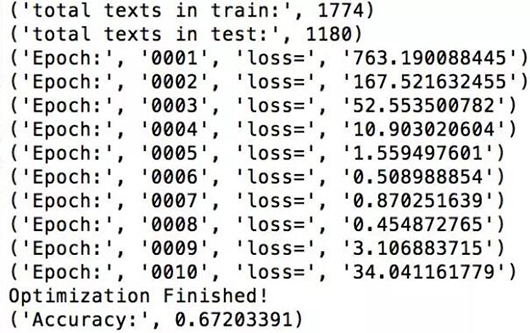在这篇文章中,作者讨论了六个关于创建机器学习模型来进行文本分类的主要话题。
- TensorFlow 如何工作
- 机器学习模型是什么
- 神经网络是什么
- 神经网络怎样进行学习
- 如何处理数据并且把它们传输给神经网络的输入
- 怎样运行模型并且得到预测结果
作者也提供了可在Jupyter notebook上运行的代码。我将回顾这六个话题并且与我自己的经验相结合。
1. TensorFlow 概览
TensorFlow 是***的开源 AI 库之一。它的高计算效率,丰富的开发资源使它被企业和个人开发者广泛采用。在我看来,学习 TensorFlow 的***的方法就是使用它的官网教程(https://www.tensorflow.org/)。在这个网站上,你可以浏览「getting started」教程。
我首先将会对 TensorFlow 的基本定义和主要特征进行介绍。张量(Tensor)是一种数据结构,它可以把原始值形成任意的多维数组【1】。张量的级别就是它的维度数。这里,我建议阅读 Python 的应用编程接口 API,因为它对 TensorFlow 的初学者来说是很友好的。你可以安装 TensorFlow 并且配置环境,紧随官方网站上的指导就可以了。测试你是否成功安装 TensorFlow 的方法就是导入(import)TensorFlow 库。在 TensorFlow 中,计算图(computational graph)是核心部件。数据流程图形用来代表计算过程。在图形下,操作(Operation)代表计算单位,张量代表数据单位。为了运行代码,我们应该对阶段函数(Session function)进行初始化。这里是执行求和操作的完整代码。
- #import the library
- import tensorflow as tf
- #build the graph and name as my_graph
- my_graph = tf.Graph()
- #tf.Session encapsulate the environment for my_graph
- with my_graph.as_default():
- x = tf.constant([1,3,6])
- y = tf.constant([1,1,1])
- #add function
- op = tf.add(x,y)
- #run it by fetches
- result = sess.run(fetches=op)
- #print it
- print(result)
你可以看见在 TensorFlow 中编译是遵循一种模式的,并且很容易被记住。你将会导入库,创建恒定张量(constant tensors)并且创建图形。然后我们应该定义哪一个图将会被在 Session 中使用,并且定义操作单元。最终你可以在 Session 中使用 run() 的方法,并且评估其中参数获取的每一个张量。
2. 预测模型
预测模型可以很简单。它把机器学习算法和数据集相结合。创建一个模型的过程程如下图所示:
我们首先应该找到正确的数据作为输入,并且使用一些数据处理函数来处理数据。然后,这些数据就可以与机器学习算法结合来创建模型了。在你得到模型后,你可以把模型当做一个预测器并且输入需要的数据来预测,从而产生结果。整个进程如下图所示:
在本文中,输入是文本,输出结果是类别(category)。这种机器学习算法叫做监督学习,训练数据集是已标注过种类的文本。这也是分类任务,而且是应用神经网络来进行模型创建的。
3. 神经网络
神经网络的主要特征是自学(self-learning),而不是进行明确地程序化。它的灵感来源于人类中枢神经系统。***个神经网络算法是感知机(Perceptron)。
为了理解神经网络的工作机制,作者用 TensorFlow 创建了一个神经网络结构。
(1) 神经网络结构
这里作者使用了两个隐蔽层(hidden layers),每一个隐蔽层的职责是把输入转换成输出层可以使用的东西【1】。***个隐蔽层的节点的数量应该被定义。这些节点叫做神经元,和权值相乘。训练阶段是为了对这些值进行调节,为了产生一个正确的输出。网络也引入了偏差(bias),这就可以让你向左或向右移动激活函数,从而让预测结果更加准确【2】。数据还会经过一个定义每个神经元最终输出的激活函数。这里,作者使用的是修正线性单元(ReLU),可以增加非线性。这个函数被定义为:
- f(x) = max(0,x)(输出是 x 或 0,无论 x 多大)
对第二个隐蔽层来说,输入就是***层,函数与***个隐蔽层相同。
对于输出层,作者使用的是 one-hot 编码来得到结果。在 one-hot 编码中,除了其中的一位值为 1 以外,所有的位元(bits)都会得到一个 0 值。这里使用三种类别作为范例,如下图所示。
我们可以发现输出节点的数量值就是类别的数量值。如果我们想要划分不同的类别,我们可以使用 Softmax 函数来使每一个单元的输出转化成 0 到 1 间的值,并且使所有单元的总和为 1。它将会告诉我们每种类别的概率是多少。
上述过程由下列代码实现:
- # Network Parameters
- n_hidden_1 = 10 # 1st layer number of features
- n_hidden_2 = 5 # 2nd layer number of features
- n_input = total_words # Words in vocab
- n_classes = 3 # Categories: graphics, space and baseball
- def multilayer_perceptron(input_tensor, weights, biases):
- layer_1_multiplication = tf.matmul(input_tensor, weights['h1'])
- layer_1_addition = tf.add(layer_1_multiplication, biases['b1'])
- layer_1_activation = tf.nn.relu(layer_1_addition)
- # Hidden layer with RELU activation
- layer_2_multiplication = tf.matmul(layer_1_activation, weights['h2'])
- layer_2_addition = tf.add(layer_2_multiplication, biases['b2'])
- layer_2_activation = tf.nn.relu(layer_2_addition)
- # Output layer with linear activation
- out_layer_multiplication = tf.matmul(layer_2_activation, weights['out'])
- out_layer_addition = out_layer_multiplication + biases['out']
- return out_layer_addition
在这里,它调用了 matmul()函数来实现矩阵之间的乘法函数,并调用 add()函数将偏差添加到函数中。
4. 神经网络是如何训练的
我们可以看到其中要点是构建一个合理的结构,并优化网络权重的预测。接下来我们需要训练 TensorFlow 中的神经网络。在 TensorFlow 中,我们使用 Variable 来存储权重和偏差。在这里,我们应该将输出值与预期值进行比较,并指导函数获得最小损失结果。有很多方法来计算损失函数,由于它是一个分类任务,所以我们应该使用交叉熵误差。此前 D. McCaffrey[3] 分析并认为交叉熵可以避免训练停滞不前。我们在这里通过调用函数 tf.nn.softmax_cross_entropy_with_logits() 来使用交叉熵误差,我们还将通过调用 function: tf.reduced_mean() 来计算误差。
- # Construct model
- prediction = multilayer_perceptron(input_tensor, weights, biases)
- # Define loss
- entropy_loss = tf.nn.softmax_cross_entropy_with_logits(logits=prediction, labels=output_tensor)
- loss = tf.reduce_mean(entropy_loss)
我们应该找到***值来使输出误差最小化。这里我们使用随机梯度下降(SGD)的方法:
通过多次迭代,我们将会得到接近于全局最小损失的权值。学习速率不应该太大。自适应瞬间评估函数(Adaptive Moment Estimation function)经常用于计算梯度下降。在这个优化算法中,对梯度和梯度的二阶矩量进行平滑处理【4】。
代码如下所示,在其它项目中,学习速率可以是动态的,从而使训练过程更加迅速。
- learning_rate = 0.001
- # Construct model
- prediction = multilayer_perceptron(input_tensor, weights, biases)
- # Define loss
- entropy_loss = tf.nn.softmax_cross_entropy_with_logits(logits=prediction, labels=output_tensor)
- loss = tf.reduce_mean(entropy_loss)
- optimizer = tf.train.AdamOptimizer(learning_ratelearning_rate=learning_rate).minimize(loss)
5. 数据操作
这一部分对于分类成功也很重要。机器学习的开发者们需要更加在意数据,这会为你节省大量时间,并让结果更加准确,因为这可以让你无需从头开始更改配置。在这里,笔者需要指出两个重点。首先,为每个单词创建一个索引;然后为每个文本创建一个矩阵,如果单词在文本中,则值为 1,否则为 0。以下代码可以帮助你理解这个过程:
- import numpy as np #numpy is a package for scientific computing
- from collections import Counter
- vocab = Counter()
- text = "Hi from Brazil"
- #Get all words
- for word in text.split(' '):
- vocab[word]+=1
- #Convert words to indexes
- def get_word_2_index(vocab):
- word2index = {}
- for i,word in enumerate(vocab):
- word2index[word] = i
- return word2index
- #Now we have an index
- word2index = get_word_2_index(vocab)
- total_words = len(vocab)
- #This is how we create a numpy array (our matrix)
- matrix = np.zeros((total_words),dtype=float)
- #Now we fill the values
- for word in text.split():
- matrix[word2index[word]] += 1
- print(matrix)
- >>> [ 1. 1. 1.]
Python 中的 Counter() 是一个哈希表。当输入是「Hi from Brazil」时,矩阵是 [1 ,1, 1]。如果输入不同,比如「Hi」,矩阵会得到不同的结果:
- matrix = np.zeros((total_words),dtype=float)
- text = "Hi"
- for word in text.split():
- matrix[word2index[word.lower()]] += 1
- print(matrix)
- >>> [ 1. 0. 0.]
6. 运行模型,获得结果
在这一部分里,我们将使用 20 Newsgroups 作为数据集。它包含有关 20 种话题的 18,000 篇文章。我们使用 scilit-learn 库加载数据。在这里作者使用了 3 个类别:comp.graphics、sci.space 和 rec.sport.baseball。它有两个子集,一个用于训练,一个用于测试。下面是加载数据集的方式:
- from sklearn.datasets import fetch_20newsgroups
- categories = ["comp.graphics","sci.space","rec.sport.baseb
- newsgroups_train = fetch_20newsgroups(subset='train', categoriescategories=categories)
- newsgroups_test = fetch_20newsgroups(subset='test', categoriescategories=categories)
它遵循通用的模式,非常易于开发者使用。
在实验中,epoch 设定为 10,这意味着会有 10 次正+反向遍历整个数据集。在 TensorFlow 中,占位符的作用是用作 Feed 的目标,用于传递每个运行步骤的数据。
- n_input = total_words # Words in vocab
- n_classes = 3 # Categories: graphics, sci.space and baseball
- input_tensor = tf.placeholder(tf.float32,[None, n_input],name="input")
- output_tensor = tf.placeholder(tf.float32,[None, n_classes],name="output")
我们应该分批训练数据,因为在测试模型时,我们会用更大的批次来输入 dict。调用 get_batches() 函数来获取具有批处理尺寸的文本数。接下来,我们就可以运行模型了。
- training_epochs = 10
- # Launch the graph
- with tf.Session() as sess:
- sess.run(init) #inits the variables (normal distribution, reme
- # Training cycle
- for epoch in range(training_epochs):
- avg_cost = 0.
- total_batch = int(len(newsgroups_train.data)/batch_size)
- # Loop over all batches
- for i in range(total_batch):
- batch_x,batch_y = get_batch(newsgroups_train,i,batch_size)
- # Run optimization op (backprop) and cost op (to get loss value)
- c,_ = sess.run([loss,optimizer], feed_dict={input_tensor: batch_x, output_tensor:batch_y})
在这里我们需要构建测试模型,并计算它的准确性。
- # Test model
- index_prediction = tf.argmax(prediction, 1)
- index_correct = tf.argmax(output_tensor, 1)
- correct_prediction = tf.equal(index_prediction, index_correct)
- # Calculate accuracy
- accuracy = tf.reduce_mean(tf.cast(correct_prediction, "float"))
- total_test_data = len(newsgroups_test.target)
- batch_x_test,batch_y_test = get_batch(newsgroups_test,0,total_test_data)
- print("Accuracy:", accuracy.eval({input_tensor: batch_x_test, output_tensor: batch_y_test}))
然后我们就可以得到结果:
结论
本文介绍了如何使用神经网络和 TensorFlow 来处理文本分类任务。它介绍了与实验有关的基础信息,然而,在我自己运行的时候,效果就没有作者那么好了。我们或许可以在这个架构的基础上改进一番,在隐藏层中使用 dropout 肯定会提高准确性。
在运行代码前,请确认你已安装了***版本的 TensorFlow。有些时候你可能会无法导入 twenty_newsgroups 数据集。当这种情况发生时,请使用以下代码来解决问题。
- # if you didn't download the twenty_newsgroups datasets, it will run with error
- # this logging can help to solve the error
- import logging
- logging.basicConfig()
以下是完整代码:
- import pandas as pd
- import numpy as np
- import tensorflow as tf
- from collections import Counter
- from sklearn.datasets import fetch_20newsgroups
- # if you didn't download the twenty_newsgroups datasets, it will run with error
- # this logging can help to solve the error
- import logging
- logging.basicConfig()
- categories = ["comp.graphics","sci.space","rec.sport.baseball"]
- newsgroups_train = fetch_20newsgroups(subset='train', categoriescategories=categories)
- newsgroups_test = fetch_20newsgroups(subset='test', categoriescategories=categories)
- print('total texts in train:',len(newsgroups_train.data))
- print('total texts in test:',len(newsgroups_test.data))
- vocab = Counter()
- for text in newsgroups_train.data:
- for word in text.split(' '):
- vocab[word.lower()]+=1
- for text in newsgroups_test.data:
- for word in text.split(' '):
- vocab[word.lower()]+=1
- total_words = len(vocab)
- def get_word_2_index(vocab):
- word2index = {}
- for i,word in enumerate(vocab):
- word2index[word.lower()] = i
- return word2index
- word2index = get_word_2_index(vocab)
- def get_batch(df,i,batch_size):
- batches = []
- results = []
- texts = df.data[i*batch_size:i*batch_size+batch_size]
- categories = df.target[i*batch_size:i*batch_size+batch_size]
- for text in texts:
- layer = np.zeros(total_words,dtype=float)
- for word in text.split(' '):
- layer[word2index[word.lower()]] += 1
- batches.append(layer)
- for category in categories:
- y = np.zeros((3),dtype=float)
- if category == 0:
- y[0] = 1.
- elif category == 1:
- y[1] = 1.
- else:
- y[2] = 1.
- results.append(y)
- return np.array(batches),np.array(results)
- # Parameters
- learning_rate = 0.01
- training_epochs = 10
- batch_size = 150
- display_step = 1
- # Network Parameters
- n_hidden_1 = 100 # 1st layer number of features
- n_hidden_2 = 100 # 2nd layer number of features
- n_input = total_words # Words in vocab
- n_classes = 3 # Categories: graphics, sci.space and baseball
- input_tensor = tf.placeholder(tf.float32,[None, n_input],name="input")
- output_tensor = tf.placeholder(tf.float32,[None, n_classes],name="output")
- def multilayer_perceptron(input_tensor, weights, biases):
- layer_1_multiplication = tf.matmul(input_tensor, weights['h1'])
- layer_1_addition = tf.add(layer_1_multiplication, biases['b1'])
- layer_1 = tf.nn.relu(layer_1_addition)
- # Hidden layer with RELU activation
- layer_2_multiplication = tf.matmul(layer_1, weights['h2'])
- layer_2_addition = tf.add(layer_2_multiplication, biases['b2'])
- layer_2 = tf.nn.relu(layer_2_addition)
- # Output layer
- out_layer_multiplication = tf.matmul(layer_2, weights['out'])
- out_layer_addition = out_layer_multiplication + biases['out']
- return out_layer_addition
- # Store layers weight & bias
- weights = {
- 'h1': tf.Variable(tf.random_normal([n_input, n_hidden_1])),
- 'h2': tf.Variable(tf.random_normal([n_hidden_1, n_hidden_2])),
- 'out': tf.Variable(tf.random_normal([n_hidden_2, n_classes]))
- }
- biases = {
- 'b1': tf.Variable(tf.random_normal([n_hidden_1])),
- 'b2': tf.Variable(tf.random_normal([n_hidden_2])),
- 'out': tf.Variable(tf.random_normal([n_classes]))
- }
- # Construct model
- prediction = multilayer_perceptron(input_tensor, weights, biases)
- # Define loss and optimizer
- loss = tf.reduce_mean(tf.nn.softmax_cross_entropy_with_logits(logits=prediction, labels=output_tensor))
- optimizer = tf.train.AdamOptimizer(learning_ratelearning_rate=learning_rate).minimize(loss)
- # Initializing the variables
- init = tf.initialize_all_variables()
- # Launch the graph
- with tf.Session() as sess:
- sess.run(init)
- # Training cycle
- for epoch in range(training_epochs):
- avg_cost = 0.
- total_batch = int(len(newsgroups_train.data)/batch_size)
- # Loop over all batches
- for i in range(total_batch):
- batch_x,batch_y = get_batch(newsgroups_train,i,batch_size)
- # Run optimization op (backprop) and cost op (to get loss value)
- c,_ = sess.run([loss,optimizer], feed_dict={input_tensor: batch_x,output_tensor:batch_y})
- # Compute average loss
- avg_cost += c / total_batch
- # Display logs per epoch step
- if epoch % display_step == 0:
- print("Epoch:", '%04d' % (epoch+1), "loss=", \
- "{:.9f}".format(avg_cost))
- print("Optimization Finished!")
- # Test model
- correct_prediction = tf.equal(tf.argmax(prediction, 1), tf.argmax(output_tensor, 1))
- # Calculate accuracy
- accuracy = tf.reduce_mean(tf.cast(correct_prediction, "float"))
- total_test_data = len(newsgroups_test.target)
- batch_x_test,batch_y_test = get_batch(newsgroups_test,0,total_test_data)
- print("Accuracy:", accuracy.eval({input_tensor: batch_x_test, output_tensor: batch_y_test}))
【本文是51CTO专栏机构“机器之心”的原创文章,微信公众号“机器之心( id: almosthuman2014)”】









































